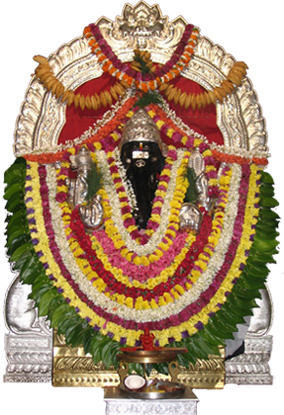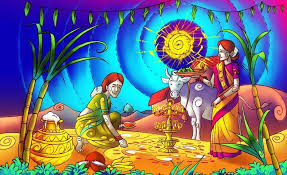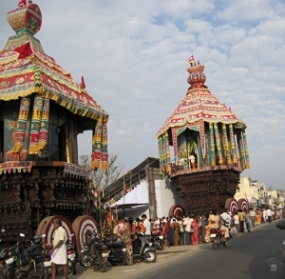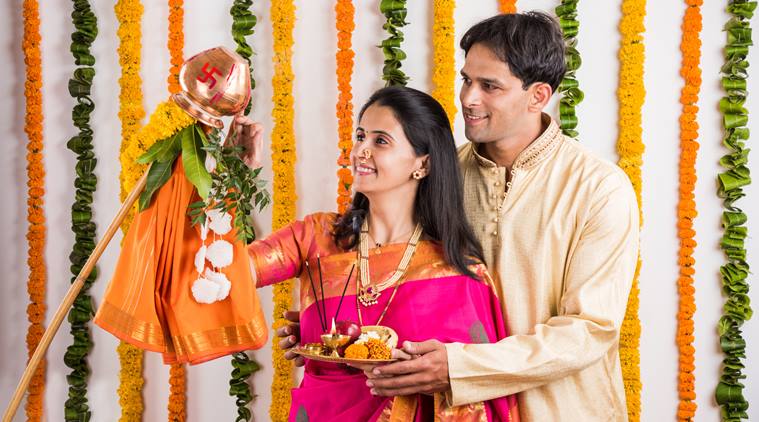Main God : Vishnu
Puthandu Festival :
Puthandu better known as Tamil New Year, is the first day of year on the Tamil calendar and is celebrated by ethnic Tamils in Tamil Nadu and Puducherry in India, Sri Lankan Tamils and Indian Tamils of Sri Lanka, and by Tamils in Malaysia, Singapore, Reunion, Mauritius and Tamil Diaspora. On this day, Tamil people greet each other by saying “puttantu Valttukkal!” or “Iṉiya tamiḻ puttantu nalvalttukkal!”. The festive occasion is in keeping with the Hindu solar calendar.
Origin and significance :
The Tamil New Year follows the vernal equinox and generally falls on 14 April of the Gregorian year. 14 April marks the first day of the traditional Tamil calendar and is a public holiday in both Tamil Nadu and Sri Lanka. The Tropical vernal equinox falls around 22 March, and adding 23 degrees of trepidation or oscillation provides the Hindu sidereal transition or Nirayana Mesha Sankranti (the solar transition into the constellation of Aries). The Tamil calendar thus begins on the same date observed by most traditional calendars in India as in Assam, West Bengal, Kerala, Manipur, Mithila, Odisha, Punjab and Tripura, and in Nepal, Bangladesh, Burma, Cambodia, Laos, Sri Lanka and Thailand. The 60-year cycle is ancient and is observed by most traditional calendars of India and China, and is related to 5 revolutions of Jupiter, or to 60-year orbit of Nakshatras (stars) as described in the Surya Siddhanta.
The 60-year cycle comes by 5 revolutions of Jupiter and 2 revolutions of Saturn. The relative position of Jupiter and Saturn in one particular year will be repeated after 60 years. The 60-year cycle was essentially conceived for predicting the climate of a particular year, as the relative position of the two major planets, Jupiter and Saturn, is recognized for its impact on climate.
The traditional Tamil year starts on 14 April 2016 [Kali Yuga 5118]. The year may also be dated according to the Vikram Samvat or Saka era.
There are several references in early Tamil literature to the April new year. Nakkirar, Sangam period author of the Neṭunalvāṭai, wrote in the third century that the sun travels from Mesha/Chitterai through 11 successive signs of the zodiac.Kūdalūr Kizhaar in the 3rd century refers to Mesha Raasi/Chitterai as the commencement of the year in the Puṟanāṉūṟu.The Tolkaapiyam is the oldest surviving Tamil grammar that divides the year into six seasons where Chitterai marks the start of the Ilavenil season or summer. The 8th century Silappadikaaram mentions the 12 Raasis or zodiac signs starting with Mesha/Chitterai. The Manimekalai alludes to the Hindu solar calendar as we know it today. Adiyarkunalaar, an early medieval commentator or Urai-asiriyar mentions the twelve months of the Tamil calendar with particular reference to Chitterai. There were subsequent inscriptional references in Pagan, Burma dated to the 11th century CE and in Sukhothai, Thailand dated to the 14th century CE to South Indian, often Vaishnavite, courtiers who were tasked with defining the traditional calendar that began in mid-April.
Celebration :
Tamil people celebrate Tamil new year on 14 April. This is the month of Chitterai, the first month of the Tamil solar calendar. On the eve of Puthandu, a tray arranged with three fruits (mango,banana and jack fruit), betel leaves and arecanut, gold/silver jewellery, coins/money, flowers and a mirror is placed. This is to be viewed upon waking in the morning. In the temple city of Madurai, the Chitterai Thiruvizha is celebrated in the Meenakshi Temple. A huge exhibition is held, called Chitterai Porutkaatchi. In some parts of Southern Tamil Nadu, it is called Chittirai Vishu. The day is marked with a feast in Tamil homes and entrances to the houses are decorated elaborately with kolams. In most parts of India, one can see neem trees blooming with their flowers and the first batch of mangoes hanging prominently. This day is celebrated by some communities with neem flowers and raw mangoes to symbolize growth and prosperity.
On the day of Tamil New Year, a big Car Festival is held at Tiruvidaimarudur near Kumbakonam. Festivals are also held at Tiruchirapalli, Kanchipuram and many other places
Sri Lankan Tamils observe the traditional new year in April with the first financial transaction known as the ‘Kai-vishesham’ where elders gift money to the unmarried young, particularly children as a token of good luck. The event is also observed with the ‘arpudu’ or the first ploughing of the ground to prepare for the new agricultural cycle. The ‘punya-kaalam’ or auspicious time when the sun reportedly shifts from Meena raasi to Mesha raasi is considered ideal to commence new activities on a favorable note. Sri Lankan Tamils begin the year with a herbal bath with ‘maruthu-neer’ with ingredients for good health. The game of ‘por-thenkai’ or coconut wars between youth is played in villages through the Tamil north and east of the island while cart races are also held.[7] The festive Puthandu season in April is a time for family visits and the renewal of filial bonds.[8] It coincides with the Sinhalese new year season.
In Malaysia and Singapore, Tamils join Sikhs, Malayalees and Bengalis to celebrate the traditional new year in mid-April with leaders across the political spectrum wishing the ethnic Indian community for the new year. Special religious events are held in Hindu temples, in Tamil community centers and Gurudwaras. Cultural programs and media events also take place. Its a day of celebration for the Indian community.
Vishu Festival:
Vishu is a Hindu festival primarily celebrated in the Indian state of Kerala, which marks the beginning of the harvest year. It is also celebrated as Bisu in South Canara regions like the Kasargod district of Kerala, Mangalore and Udupi district of Karnataka, India and as Bihu in Assam. Vishu falls on the month of Medam in the Malayalam calendar, usually in the second week of April in the Gregorian calendar.
Vishu is celebrated with much fanfare and vigour in all parts of Kerala by Hindus. It is considered a festival of light and fireworks,and decorating lights and bursting of firecrackers (Vishupadakkam) is part of the celebration. Other elements of Vishu include buying of new clothes (Puthukodi) for the occasion, the tradition of giving money called Vishukkaineetam , and the Vishu feast or Sadya, which consist of equal proportions of salty, sweet, sour and bitter items. Feast items include Veppampoorasam, Mampazhappulissery, Vishu kanji and Vishu katta .
The most important event in Vishu is the Vishukkani, which literally means “the first thing seen on the day of Vishu after waking up”. The Vishukkani consists of a ritual arrangement of auspicious articles intended to signify prosperity, including rice, fruits and vegetables, betel leaves, arecanut, metal mirror, yellow flowers called konna (Cassia fistula), holy texts and coins, all arranged around lord Krishna in an ambience lit by nilavilakku or tookkuvilakku (traditional oil lamps) usually in the prayer room of the house. This is arranged the night before Vishu and is the first sight seen on Vishu. On Vishu, devotees often visit temples like Sabarimala Ayyappan Temple or Guruvayur Sree Krishna temple to have a ‘Vishukkani Kazhcha’ (viewing) in the early hours of the day.
Belief :
Interesting belief is related to the demon king Ravana. Ravana had never allowed Surya deva (Sun God) to rise straight from the East and after Ravana’s death it was on a Vishu day, that Surya deva started to rise from the East. Hindus of Kerala and nearby places celebrate Vishu to commemorate the return of Surya deva.
Significance :
The day of Vishu is often considered as the first day of the Zodiac Calendar. However, if the transit of Sun into Aries (Mesha Sankramana) occurs after dawn on the first day of the zodiac calendar, then the Vishu celebrations will be on the next day, i.e. the second day of the calendar. In 2014, first day of the calendar was on 14 April but the transit of Sun into Aries (Mesha Sankramana) occurred after 7 am. Therefore, Vishu was celebrated on 15 April 2014. The Vishu Kani is meant to bring luck and prosperity for the year starting from Vishu Day Medam 1st. As Vishu marked the first day of the Malayalam Zodiac, it is considered an appropriate time to offer oblations to Hindu gods.
Vishu signifies the sun’s transit into the Meda Raasi (first zodiac sign) according to Indian astrological calculations, and falls on the spring equinox.During the equinox, a day has equal number of hours of daylight and darkness,which describes the origin of the word “Vishu” which in Sanskrit means “equal”. Vishu is a festival, on which farmers in kerala begins their agriculture activities
Rituals and Customs :
Vishukkani (the Vishu sight)
The Malayalam word “kani” literally means “that which is seen first”, so “Vishukkani” means “that which is seen first on Vishu”. The Vishukkani consists of a ritual arrangement of auspicious articles intended to signify prosperity, such as
- Rawrice
- Freshlemon
- Goldencucumber
- CoconutCoconut
- JackFruit
- KanmashiKajal
- Betel leaves
- Arecanut
- Metal mirror
- Konna flowers (Cassia fistula) – these are yellow flowers which usually bloom around the same time as Vishu
- Holy texts
- Coins and currency notes
These are arranged in a bell metal vessel called uruli in the puja room of the house. A lighted bell metal lamp called nilavilakku is also placed alongside. This is arranged the night before Vishu. On Vishu, the custom is to wake up at dawn and go to the prayer room of the house, with eyes closed so that the Vishukkani is the first sight in the new season. According to the age-old belief of Malayalees, an auspicious kani at dawn on the Vishu day is lucky for the entire year. As a result, the Vishukkani is prepared with a lot of care to make it a positive sight and bring a wonderful, prosperous year ahead. Reading verses from the Hindu Holy book Ramayanam after seeing the Vishukkani is considered auspicious. It is also believed that the page of the Ramayanam which is opened up will have a bearing on one’s life in the coming year.
Vishu Sadya :
The Sadhya (feast) is a major part of all Kerala festivals. However, Vishu Kanji, Thoran and Vishu katta are more important during Vishu. The Kanji is made of rice, coconut milk and spices. Vishu katta is a delicacy prepared from freshly harvested rice powder and coconut milk served with jaggery.For Thoran, the side dish, there are also mandatory ingredients. Other important Vishu delicacies include Veppampoorasam (a bitter preparation of neem) and Mampazhappulissery (a sour mango soup)






